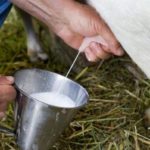You can make various dietary products from goat milk - cottage cheese, kefir, cheese. It is pleasant to consume fresh milk that does not have any unusual tastes or odors. Situations often occur when a steamed product has a strange color and consistency. Many housewives are concerned about the question of why goat milk is sometimes salty. This deficiency can occur for various reasons.
Why does a goat have salty milk?
Various factors can affect the standard color and flavor of goat milk. The most common:
- animal disease. Most often, a salty taste occurs with mastitis.Symptoms of inflammation: mammary gland enlarges 2-3 times, temperature rises in the affected half, and redness appears. A specific sweet-sweet taste may also be a sign of illness;
- poor feeding ration - tree foliage, bush branches;
- poor living conditions - poorly ventilated area, dirty bedding and food containers.
The saltiness of the paired product is most often seen in older goats. An unusual taste of milk also appears after lambing of females or in the first/last days of lactation, which is explained by an increase in salts in colostrum. Sometimes hormonal changes in animals caused by the dry period also provoke the appearance of salts in milk.
What to do in this case?
It is impossible to change the taste of milk by simply boiling it. If a specific taste appears, you need to find out the reasons for its appearance. To detect mastitis in a timely manner, it is recommended to show the animal to a veterinarian. Otherwise, if you start the disease, you can lose the goat.
The appearance of salinity is often caused by the prenatal state of the goat - launching. Pregnancy lasts 5 months, and about a month before birth, a salty taste may appear in the milk. The saltiness usually goes away naturally about a month after giving birth.
If the taste is not associated with mastitis or pregnancy, then you need to reconsider your diet. In summer, it is recommended to graze the goat on forbs. You can feed a mixture of whole grains (barley, corn, wheat). Sprouted grains of barley, wheat, and dried fruit (apples, pears) are used as additives. Of course, this way the taste of the product cannot be changed in 2-3 days, but this is a sure way to improve its quality.
How to prevent the problem from occurring?
Saltiness in the milk may appear if the goat has not been milked for 7-10 days. With such a break, milk stagnates in the goat’s udder, which affects the taste. The problem needs to be solved gradually. And in the future, you should not leave the goat for a long time without proper care.
If the appearance of salinity is associated with mastitis, then the causes of its occurrence must be eliminated. Inflammation of the mammary gland causes decreased immunity and endometritis. It is necessary to eliminate the risk of mechanical damage to the udder: cuts, bruises, poor hygiene. Dirty bedding, drafts, and cold floors also provoke inflammation.
It is important to take time to review your diet. Before lambing, straw is removed from the feed due to its low nutritional value, and wheat or barley grain is crushed. Digestive pathologies and changes in the taste of milk are caused by feeding animals large amounts of silage (especially sour), concentrates, and rotted hay. To milk a goat after lambing, the diet is formed from meadow hay, vegetables (carrots, beets, turnips), barley straw, and corn silage.
Goat's milk is superior in quality to cow's milk and has medicinal properties. The taste of milk is determined by a number of factors: the breed of the animal, age, feeding and maintenance characteristics. The quality of the product can only be corrected by revising the diet and improving living conditions.
















